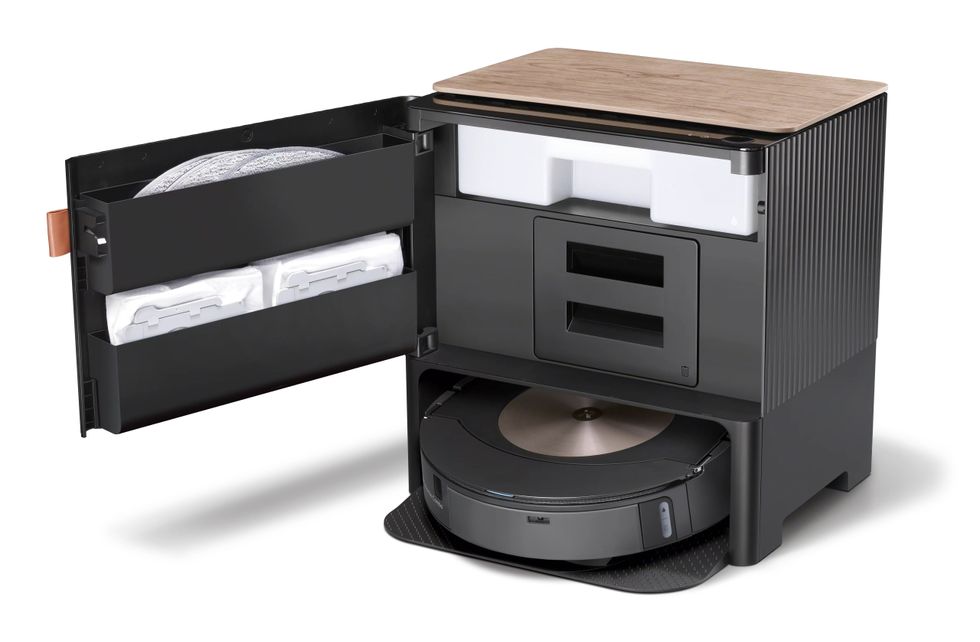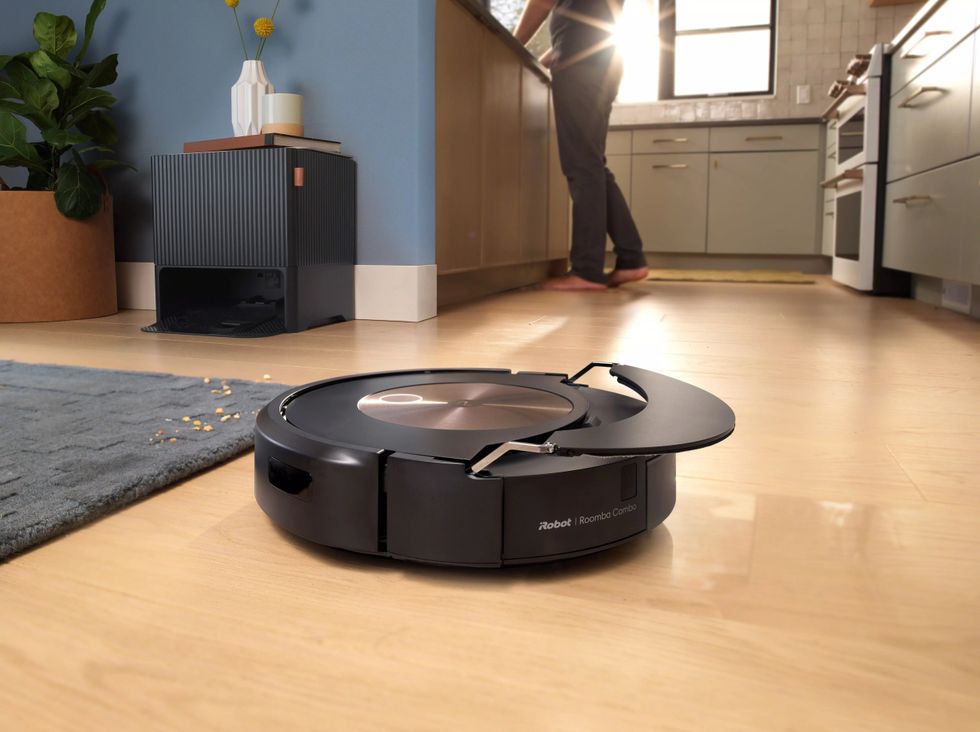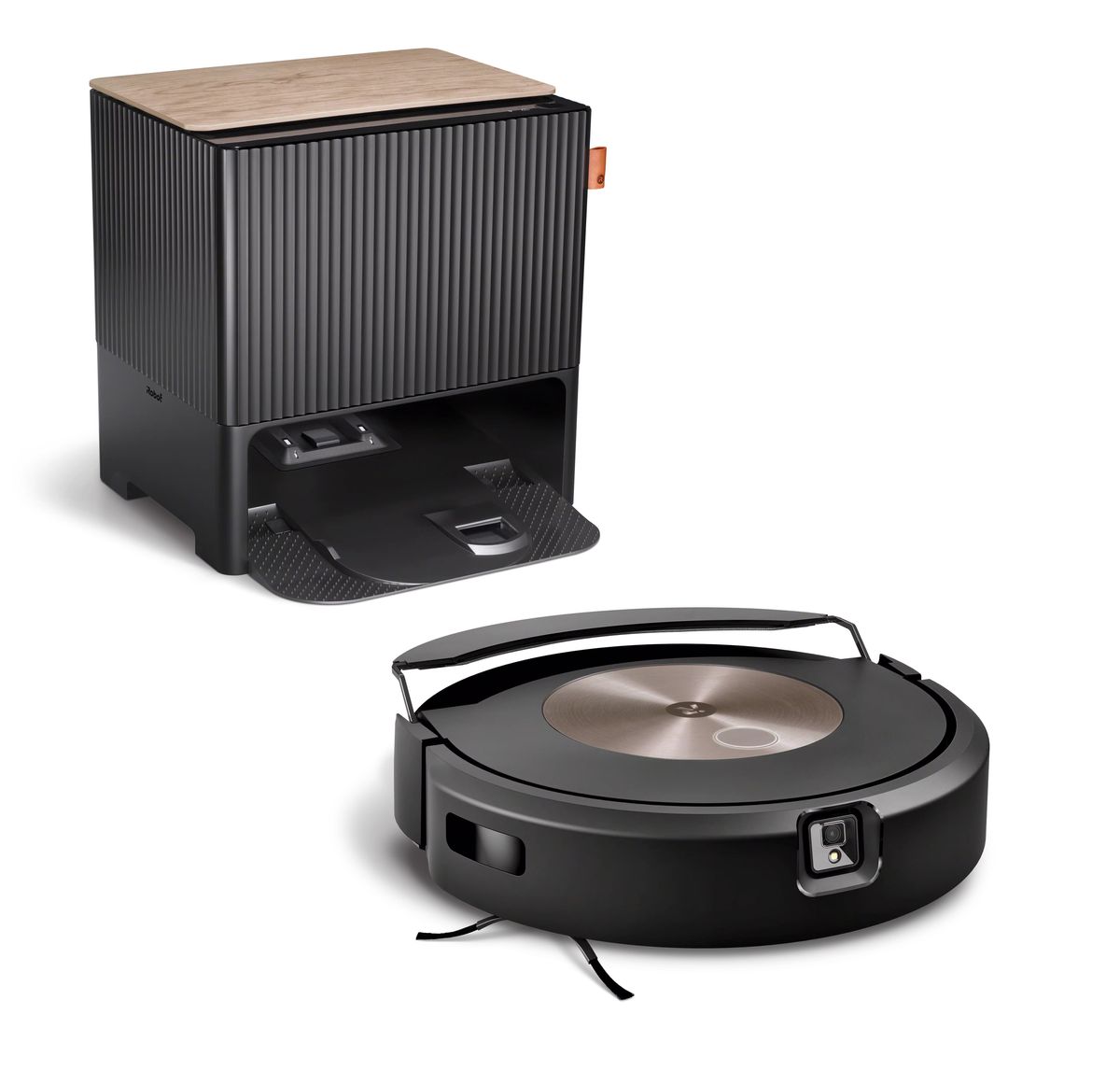Today, iRobot is announcing the newest, fanciest, and most expensive Roomba yet. The Roomba Combo j9+ trades a dock for what can only be described as a small indoor robot garage, which includes a robot-emptying vacuum system that can hold two months of dry debris along with a water reservoir that can provide up to 30 days of clean water to refill the robot’s mopping tank. Like all of iRobot’s new flagship products, the Combo j9+ is very expensive at just under US $1,400. But if nothing else, it shows us where iRobot is headed—toward a single home robot that can do everything without you having to even think about it. Almost.
The j9+ (I’m going to stop saying “Combo” every time, but that’s the one I’m talking about) is essentially an upgraded version of the j7+, which was introduced a year ago. It’s a Roomba vacuum that includes an integrated tank for clean water, and on hard floors, the robot can rotate a fabric mopping pad from on top of its head to under its butt to mop up water that it squirts onto the floor underneath itself. On carpet, the mopping pad gets rotated back up, ensuring that your carpet doesn’t get all moppy.
The biggest difference with the j9+ is that rather than having to manually fill the robot’s clean-water tank before every mopping session, you can rely on a dock that includes a huge 3-liter clean water tank that can keep the robot topped off for a month. This also means that the robot can mop more effectively, since it can use more water when it needs to and then return to the dock midcycle to replenish if necessary.
This all does turn the dock into a bit of a monster. It’s a dock in the space-dock sense, not the boat-dock sense—it’s basically a garage for your Roomba, nothing like the low-profile charging docks that Roombas started out with. iRobot is obviously aware of this, so they’ve put some effort into making the dock look nice, and all of the guts can now be accessed from the front, making the top a usable surface.

iRobot is not the only company offering hybrid vacuuming and mopping robots with beefy docks. But these have come with some pretty significant compromises, like with robots that just lift the mopping pad up when they encounter carpet rather than moving the pad out of the way entirely. This invariably results in a mopping pad dripping dirty water onto your carpet, which is not great. In iRobot’s internal testing, “we’ve seen competitive robots get materially worse,” says iRobot CEO Colin Angle. iRobot is hardly an unbiased party here, but there’s a reason that Roombas tend to be more expensive than their competitors, and iRobot argues that its focus on long-term reliability in the semi-structured environment of the home is what makes its robots worth the money.
Mapping and localization is a good example of this, Angle explains, which is why iRobot relies on vision rather than lasers. “Lasers are the fastest way to create a map, but a geometry-based solution is very brittle to a changing environment. They can’t handle a general rearranging of furniture in a room.” iRobot’s latest Roombas use cameras that look up toward the ceiling of rooms, tracking visual landmarks that don’t change very often: When was the last time you rearranged your ceiling? This allows iRobot to offer map stability that’s generational across robots.
iRobot did experiment with a depth sensor on the 2019 Roomba S9, but that technology hasn’t made it into a Roomba since. “I am currently happy with one single camera,” Angle tells us. “I don’t feel like anything we’re doing on the robot is constrained by not having a 3D sensor. And I don’t yet have arms on the robot; certainly if we’re doing manipulation, depth would become very important, but for the moment in time, I think there’s a lot more you can get out of a monocular camera. 3D is on our road map for when we’re going to do a step-change in functionality that doesn’t exist in the market today.”
So what’s left to automate here? What is the next generation Roomba going to offer that these latest ones don’t, besides maybe arms? The obvious thing is something that other robotic vacuum companies already offer: cleaning the grungy mopping pad by using a pad-washing system within the dock. “It’s a great idea,” says Angle, but iRobot has not been able to come up with a system that can do this to his satisfaction. You have to wash a robot’s mopping pad with something, like some kind of cleaning fluid, and then that used cleaning fluid has to go somewhere. So now you’re talking about yet another fluid reservoir (or two) that the user has to manage plus an even larger dock to hold all of it. “We don’t have a solution,” Angle says, although my assumption is that they’re working hard on something.
The water-related endpoint for floor care robots seems to be plumbing integration; a system that can provide clean water and accept dirty water on-demand. A company called SwitchBot is already attempting to do this with a water docking station that links into undersink plumbing. It’s more functional than elegant, because I can promise you that zero people have a house designed around robot-accessible plumbing, but my guess is that new houses are going to start to get increasingly robot-optimized.
In the meantime, dealing with a dirty mopping pad is done the same way as with the previous model, the j7+: You remove the pad, which I promise is super easy to do, drop it in the laundry, and replace it with a clean one. It means that you have to physically interact with the robot at least once for every mopping cycle, which is something that iRobot is trying really hard to get away from, but it’s really not that big of an ask, all things considered.
One issue I foresee as Roombas get more and more hands-off is that it’ll get harder and harder to convince people to do maintenance on them. Roombas are arguably some of the most rugged robots ever made, considering that they live and work in semi-structured environments supervised by untrained users. But their jobs are based around spinning mechanical components in contact with the ground, and if you have pets or live with someone with long hair, you know what the underbelly of a Roomba can turn into. A happy Roomba is a Roomba that gets its bearings cleaned out from time to time, and back when we all had to empty our Roomba’s dustbin after every cleaning cycle, it was easy to just flip the robot over and do a quick hair extraction. But with Roombas now running unsupervised for weeks or months at a time, I worry for the health of their innards.
While it’s tempting to just focus on the new hardware here, what makes robots actually useful is increasingly dependent on software. The j9+ does things that are obvious in retrospect, like prioritizing what rooms to clean based on historical dirt measurements, doing a deeper cleaning of bathroom floors relative to hardwood floors, and using a new back-and-forth “scrubbing” trajectory. That last thing is actually not new at all; Evolution Robotics’ Mint was mopping that way back in 2010. But since iRobot acquired that company in 2012, we’ll give it a pass. And of course, the j9+ can still recognize and react to 80-something household objects, from wayward socks to electrical cords.

I asked Angle what frustrates him the most about how people perceive robot vacuums:
“I wish customers didn’t have a honeymoon period where the robot’s ability to live up to expectations wasn’t ignored,” he told me. Angle explains that when consumers first get a robot, for at least the first few weeks, they cut it plenty of slack, frequently taking the blame for the robot getting lost or stuck. “During the early days of living with a robot, people think the robot is so much smarter than it actually is. In fact, if I’m talking to somebody about what they think their robot knows about every room in their house, it’s like, I’m sorry, but even with unlimited resources and time I have no idea how I’d get a Roomba to learn those things.” The problem with this, Angle continues, is that the industry is increasingly focused on optimizing for this honeymoon period, meaning that gimmicky features are given more weight than long-term reliability. For iRobot, which is playing the long game (just ask my Roomba 560 from 2010!) this may put them at a disadvantage in the trigger-happy consumer market.
The Roomba Combo j9+ is available to ship 1 October for $1,399.99. There’s also a noncombo Roomba j9+, which includes a mopping function in the form of a swappable bin with a mopping pad attached and comes with a much smaller dock, for $899.99. If those prices seem excessive, that’s totally reasonable, because again, iRobot’s latest and greatest robots are always at a premium—but all of these new features will eventually trickle down into Roombas that are affordable for the rest of us.
Evan Ackerman is a senior editor at IEEE Spectrum. Since 2007, he has written over 6,000 articles on robotics and technology. He has a degree in Martian geology and is excellent at playing bagpipes.



